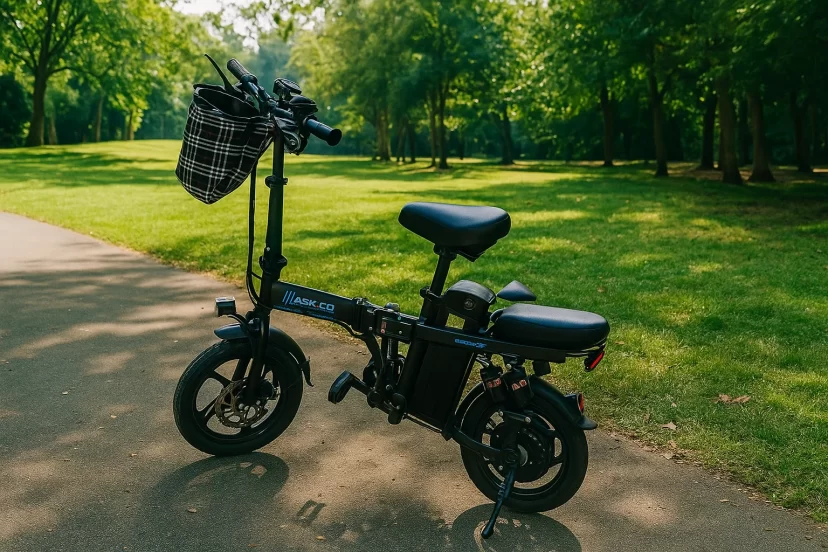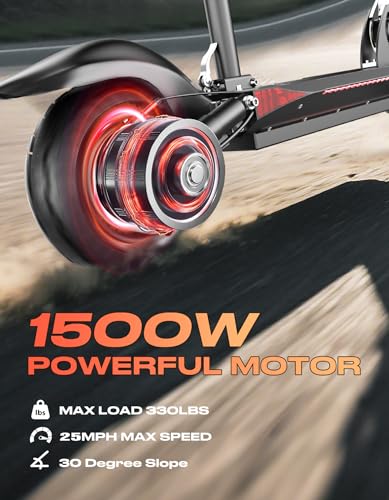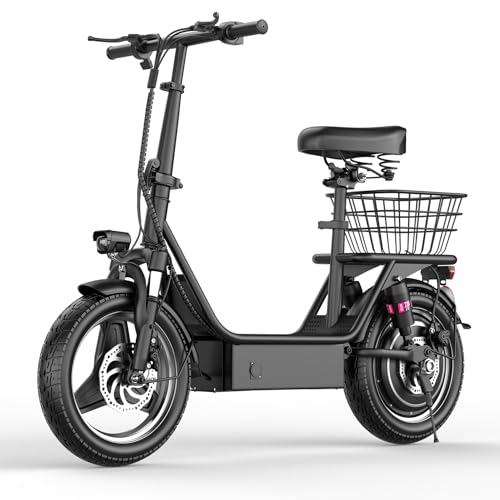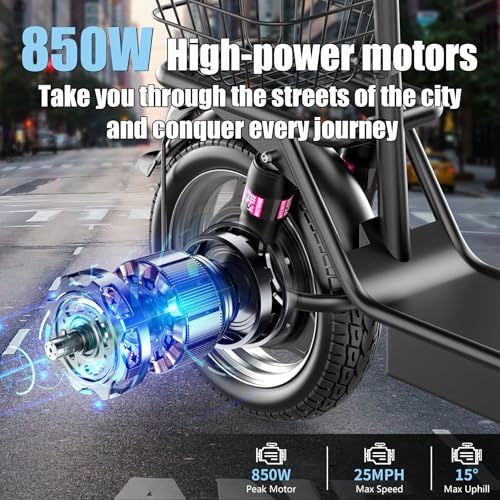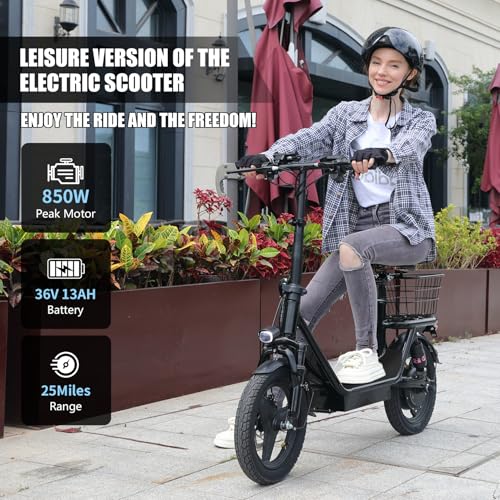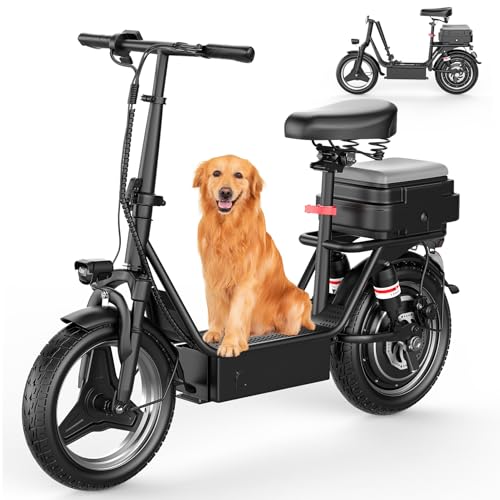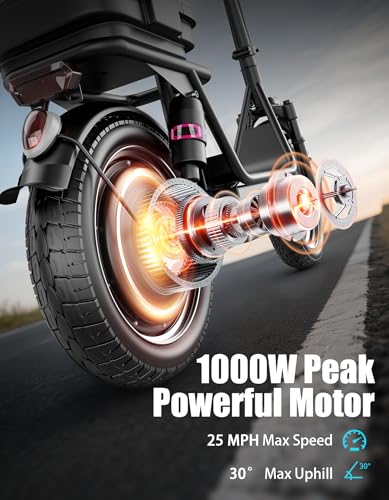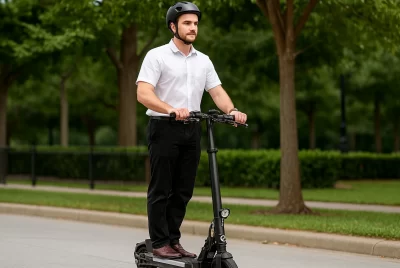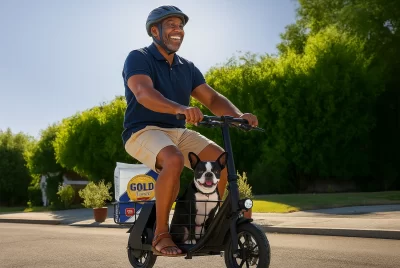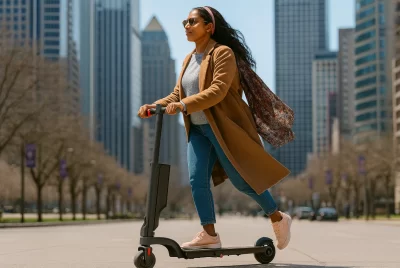ASKGO Electric Scooter Review
*We may earn a commission for purchases made using our links. Please see our disclosure to learn more.
Urban commuting has evolved dramatically over the past few years, and electric scooters have emerged as one of the most practical solutions for navigating crowded city streets. Among the various brands available, the ASKGO electric scooter has positioned itself as a versatile option with models featuring powerful motors up to 650W peak, ranges extending to 30 miles, and speeds reaching 20-25 mph. This comprehensive guide explores everything riders need to know about choosing, using, and maximizing the potential of ASKGO electric scooters for everyday transportation needs.
“Electric scooters are the ultimate commuter hack. For zipping to the office, running errands, or just cruising to enjoy the cityscape, electric scooters are a sleek, efficient, and environmentally friendly way to get around town.”
— Road & Track, Best Electric Scooters for Adults in 2025
Key Takeaways
- Performance Range: ASKGO scooters offer varied performance levels with motors ranging from 350W to 800W, suitable for different rider needs
- Comfortable Design: Most models feature adjustable seats, dual shock absorption systems, and spacious decks for enhanced riding comfort
- Smart Features: LCD displays provide real-time data on battery level, speed, and mileage tracking
- Safety First: Dual disc brakes, bright LED lights, and sturdy construction ensure secure riding experiences
- Practical Storage: Removable baskets and rear boxes accommodate cargo up to 39.6 lbs, making errands easier
Recommended ASKGO Electric Scooter
ASKGO Electric Scooter Q2
The ASKGO Electric Scooter redefines convenience and performance for adult riders seeking a powerful and reliable ride. Featuring a 1500W peak motor, this foldable e-scooter reaches speeds up to 25 MPH, giving you the perfect balance between thrill and control. With a high-capacity 48V 13AH battery, you can travel up to 45 miles on a single charge — ideal for daily commuting, weekend adventures, or long-distance errands.
The ASKGO Electric Scooter Q2 stands out as one of the most versatile e-scooters for adults, blending power, range, and comfort in one sleek package. With its 1500W peak motor, riders can enjoy rapid acceleration and a top speed of 25 MPH, perfect for both city commutes and off-road adventures. The 48V 13AH battery offers an impressive 45-mile range, ensuring dependable performance for long-distance rides without constant recharging.
- Powerful Performance: The 1500W peak motor ensures quick acceleration and maintains speeds up to 25 MPH for smooth, efficient travel.
- Extended Range: Offers up to 45 miles per charge, reducing the need for frequent recharging during longer commutes or leisure rides.
- Comfortable Ride: Equipped with 10-inch pneumatic tires and dual suspension to handle bumps and uneven terrain effortlessly.
- Charging Time: A full recharge may take several hours, which could be inconvenient for heavy daily use.
- Weight: Its durable build adds some heft, making it slightly less portable than lighter e-scooters.
- Price Point: Premium performance and range come at a higher cost compared to basic commuter models.
ASKGO Electric Scooter K8
The ASKGO Electric Scooter for Adults combines practicality, performance, and comfort in a sleek foldable design. Powered by an 850W peak motor, this e-scooter can reach speeds up to 25 MPH, offering an efficient and exciting ride for commuting, errands, or weekend cruising. The 36V 13Ah (468Wh) battery provides a 25-mile range on a single charge, and with a quick-charge time of 3–5 hours, you’ll spend more time riding and less time waiting.
The ASKGO Electric Scooter K8 is a smart and comfortable way to travel, designed for riders who value both performance and practicality. Equipped with an 850W peak motor, it achieves a top speed of 25 MPH, offering a fun yet controlled ride. Its 36V 13Ah battery delivers a range of up to 25 miles, perfect for daily commutes, quick errands, or leisurely weekend rides.
- Convenient Design: Foldable structure with a rear basket for carrying groceries or personal items — ideal for city commutes.
- Efficient Charging: Quick 3–5-hour recharge time with a 25-mile range ensures dependable performance for daily use.
- Stable & Comfortable Ride: Dual suspension, 14-inch tires, and a padded seat deliver smooth comfort across different terrains.
- Limited Range: While 25 miles is solid for short commutes, it may not suit long-distance riders.
- Heavier Build: The seat, basket, and frame add extra weight, making it less portable for carrying upstairs.
- Moderate Power: The 850W motor handles city rides well but may feel underpowered on steep hills or rough off-road paths.
ASKGO Electric Scooter K10
Experience a new level of power, comfort, and convenience with the ASKGO Electric Scooter K10. Equipped with a 1000W peak motor, this adult e-scooter delivers impressive acceleration and can climb hills up to 30% incline with ease. Reaching speeds of up to 25 MPH, it’s designed to make both your commutes and leisure rides faster and more enjoyable.
The ASKGO Electric Scooter K10 is the perfect combination of strength, stability, and style for adult riders who value both performance and comfort. Featuring a 1000W peak motor, it conquers steep hills with up to 30% incline while maintaining a top speed of 25 MPH — ideal for commuting, errands, or leisurely rides around town.
- Powerful Performance: 1000W motor delivers excellent acceleration, hill-climbing ability, and a top speed of 25 MPH.
- Extended Range: The 48V 15Ah battery offers up to 35 miles per charge — ideal for longer commutes or weekend trips.
- Enhanced Comfort: Dual suspension, 14-inch pneumatic tires, and adjustable seat ensure a smooth and comfortable ride on all terrains.
- Charging Time: Full charge takes about 5–6 hours, slightly longer than smaller-capacity models.
- Bulky Design: The rear box and wider deck make it less compact for carrying upstairs or on public transport.
- Higher Price: Premium features and build quality come at a steeper cost than entry-level scooters.
Understanding the Electric Scooter Revolution
The shift toward micro-mobility solutions reflects changing attitudes about urban transportation. Traditional commuting methods—sitting in traffic, waiting for buses, or cramming into subway cars—no longer represent the only options. Electric scooters bridge the gap between walking and driving, offering flexibility that matches modern lifestyle demands.
Cities worldwide have recognized this transformation. Different cities, states, and countries maintain varying regulations regarding electric scooter use, with common laws often including helmet requirements, speed limits typically around 15-20 mph, and age restrictions. Before purchasing any electric scooter, understanding local regulations ensures compliance and safe operation.
The appeal extends beyond mere convenience. Electric scooters represent environmentally conscious choices, producing zero direct emissions while reducing dependency on fossil-fuel-powered vehicles. For short to medium-distance trips, they deliver unmatched efficiency, often completing journeys faster than cars stuck in congested traffic.
ASKGO Electric Scooter Models and Specifications
Founded in 2008, ASKGO operates as a comprehensive company handling both production and sales, committed to providing new, cool modes of e-bikes and scooters that make lives easier and more fun. Their product lineup spans multiple performance tiers, accommodating various rider requirements and budgets.
Entry-Level Commuters
The ASKGO S5 represents an accessible entry point into electric scooter ownership. Equipped with a 350W motor and high-capacity battery, the S5 achieves ranges up to 21 miles with maximum speeds of 19 mph, supporting loads up to 265 lbs. This model prioritizes reliability and ease of use, making it suitable for shorter commutes and casual riding.
The S5 features 8.5-inch honeycomb solid tires designed for maintenance-free operation, eliminating concerns about punctures during daily use. For riders who prioritize low maintenance over pneumatic tire comfort, this design choice proves practical. The front and rear shock absorption system helps mitigate bumps, though the ride quality differs from air-filled tire alternatives.
Safety features include a dual braking system combining electronic and mechanical braking, along with bright headlights for visibility during evening rides. The S5 has passed UL2272 testing, ensuring it meets recognized safety standards for electrical systems.
Mid-Range Performance Models
The ASKGO K8 and similar mid-tier models elevate the riding experience with enhanced power and comfort features. The K8 combines a 500W motor with 650W peak output and either 36V 13Ah or 48V 13Ah batteries, achieving top speeds around 20-25 mph with ranges up to 30 miles on single charges.
What distinguishes these models from basic commuters involves several key features:
- Seating Comfort: The K8 includes an adjustable seat with soft, breathable materials that accommodate riders from 5’1″ to 6’1″ tall, suitable for adults and teenagers. This adjustability ensures proper ergonomics across different body types, reducing fatigue during extended rides.
- Tire and Suspension Systems: Thick, sturdy 14-inch tires combined with front and rear dual shock absorbers absorb most road impacts, providing comfortable rides. Larger tires roll over obstacles more easily than smaller alternatives, improving overall ride quality on imperfect pavement.
- Storage Solutions: A removable rear basket can carry up to 39.6 lbs (18 kg), with total load capacities reaching 300 lbs. This practical addition transforms the scooter from purely personal transport into a capable errand-running vehicle.
- Information Display: The LCD display shows real-time riding conditions including battery level, current speed, speed mode, single and total mileage. This data helps riders plan trips confidently, avoiding unexpected battery depletion.
High-Performance Options
For riders seeking maximum capability, ASKGO offers premium models like the K6 Pro and Q2. The K6 Pro features a 2000W dual motor system achieving top speeds of 45 mph with ranges up to 40 miles, equipped with 11-inch off-road pneumatic tires and front and rear spring suspension.
The Q2 model sports an 800W brushless hub motor reaching 27 mph top speeds with ranges between 25-35 miles, featuring 10-inch solid tires designed for explosion-proof, puncture-proof, and anti-skid performance. These specifications position high-performance ASKGO models as legitimate car alternatives for many commuting scenarios.
The engineering challenges of building powerful electric scooters involve balancing multiple factors. Higher speeds require stronger braking systems, more robust frames, and enhanced stability features. The K6 Pro supports up to 350 lbs while maintaining durability through quality construction.
Practical Advantages of Electric Scooter Commuting
Traditional transportation methods impose numerous constraints that electric scooters elegantly sidestep. Consider the typical morning commute: driving requires finding parking, often expensive and time-consuming. Public transportation operates on fixed schedules, demanding passengers adjust their timing to match bus or train arrivals rather than personal preferences.
Electric scooters eliminate these friction points. They fold compact enough for indoor storage, avoiding parking fees entirely. Rides begin exactly when desired, without waiting for scheduled departures. The K8 electric scooter can be easily folded and stored with the basket in car trunks or taken on public transportation, with compact size and lightweight frames facilitating easy transport.
The financial calculus favors scooters as well. Considering very good electric scooters cost around or even below $750, combined with time savings compared to waiting for public transport or sitting in traffic, they represent sensible investments. Operating costs remain minimal—electricity for charging costs pennies compared to gasoline prices.
Environmental benefits compound these practical advantages. Each trip taken on an electric scooter rather than in a car reduces carbon emissions, contributing to cleaner urban air quality. While individual impact appears modest, collective adoption of micro-mobility solutions creates measurable environmental improvements.
Overcoming Common Electric Scooter Concerns
Prospective riders often harbor legitimate concerns about electric scooter adoption. Addressing these worries directly helps potential users make informed decisions.
Weather and Seasonal Limitations
Rain, cold, and extreme heat pose challenges for scooter riders. Unlike enclosed vehicles, riders experience weather directly. However, proper preparation mitigates most issues. Waterproof jackets and pants enable riding in light rain. High-brightness front lights and rear brake lights serve as night guardians for safe visibility, which also helps during foggy or overcast conditions.
Winter riding requires additional considerations. Cold temperatures reduce battery efficiency, decreasing range. Icy conditions make riding dangerous, necessitating alternative transportation. However, many regions experience sufficient mild weather days for scooters to remain practical year-round primary or secondary transport options.
Safety Considerations
Sharing road space with cars understandably concerns new riders. Prioritizing safety features such as reliable braking systems including regenerative and disc brakes, along with front and rear lights and reflectors, enhances visibility especially during night or low-light riding.
Defensive riding practices prove essential. Assuming drivers don’t see you, making eye contact at intersections, and avoiding riding in blind spots all reduce accident risks. Wearing helmets remains non-negotiable—head injuries from scooter accidents can prove devastating, while helmets provide substantial protection.
In many places, electric scooters aren’t allowed on sidewalks, requiring riders to use bike lanes, and checking local regulations before riding ensures compliance. Understanding where scooters legally operate prevents tickets and conflicts with pedestrians.
Range Anxiety and Planning
Running out of battery mid-trip represents a common fear. Smart LCD displays clearly show real-time battery levels, preventing riders from getting stuck unexpectedly. This transparency enables confident trip planning.
Establishing charging routines prevents range issues. Plugging in overnight ensures full battery capacity each morning. Some riders keep portable chargers at work for mid-day top-ups, effectively doubling daily range. Understanding realistic range expectations for your model and typical riding conditions allows accurate trip planning.
Maintenance and Durability Questions
Will electric scooters withstand daily use? Build quality varies significantly across brands and price points. Buying from trusted manufacturers and well-known brands proves smart, as cheap off-brand scooters often require more regular repair, maintenance, and new parts replacement.
ASKGO models emphasize durability. The company provides 12 months of service coverage with return and exchange options for different parts. This warranty support indicates manufacturer confidence in product reliability.
Regular maintenance extends scooter lifespan. Checking tire pressure (for pneumatic tires), ensuring brakes function properly, keeping electrical connections clean, and storing scooters away from extreme temperatures all contribute to longevity.
Maximizing Your ASKGO Electric Scooter Experience
Owning an electric scooter represents just the beginning. Optimizing usage patterns and understanding best practices enhances the overall experience significantly.
Choosing the Right Model for Your Needs
ASKGO’s diverse lineup means matching specific requirements with appropriate models. Commuters traveling under 10 miles daily with smooth roads might find the S5 sufficient. Those covering longer distances or encountering hills benefit from K8 or K11 power levels. Riders seeking maximum versatility or occasional longer trips should consider higher-capacity battery options.
Height and weight considerations matter. Adjustable seats accommodate people from 5’1″ to 6’1″ tall on mid-range models, but verifying specifications ensures comfortable fit. Weight capacity limits should provide buffer room beyond rider weight to accommodate cargo and avoid strain on motors and frames.
Riding Technique and Efficiency
Smooth, efficient riding extends range and improves comfort. Gradual acceleration rather than aggressive starts conserves battery. Maintaining steady speeds proves more efficient than constant speed changes. Anticipating stops and coasting rather than braking hard whenever possible maximizes regenerative braking benefits.
Body positioning affects aerodynamics and control. Standing with slightly bent knees absorbs bumps better than rigid posture. When seated, proper saddle height allows comfortable leg extension without strain. Leaning into turns maintains balance, while keeping weight centered enhances stability.
Storage and Cargo Management
Removable rear baskets carrying 39.6 lbs enable practical errand running, transforming scooters into genuine car alternatives for many tasks. Securing loads properly prevents shifting that affects handling. Using bungee cords or cargo nets keeps items stable during transit.
Understanding weight distribution improves safety. Heavy items positioned low and centered maintain stability better than top-heavy loads. Unbalanced cargo creates handling difficulties, especially during turns or braking.
Battery Care and Longevity
Lithium batteries powering electric scooters degrade over time, but proper care maximizes lifespan. Users should regularly check battery and charging equipment condition, ensure using matching batteries with correct charging methods, and avoid charging in unventilated places or flammable environments.
Partial charging rather than always draining to zero extends battery life. Storing scooters at moderate temperatures prevents accelerated degradation—extreme heat or cold damages batteries. If storing scooters for extended periods, maintaining charge around 50-60% optimizes long-term battery health.
Real-World Applications and Use Cases
Understanding how different riders utilize electric scooters illustrates their versatility and practical benefits across various situations.
Daily Commuters
Office workers covering 5-15 miles each way represent the primary electric scooter demographic. These riders prioritize reliability, comfort, and sufficient range for round trips. Mid-range ASKGO models like the K8 excel in this role, offering comfortable seated riding for extended periods while maintaining adequate power for moderate hills.
Morning routines simplify with scooters ready in hallways or garages rather than requiring car retrieval from parking structures. Arrival timing becomes precise rather than depending on traffic variability. The physical activity component—even with seated riding, riders engage core muscles—provides health benefits without intensive exertion.
Last-Mile Solutions
Many commuters combine multiple transportation modes, using scooters for segments traditional public transit handles poorly. Riding from home to train stations, then from destination stations to workplaces solves the “last mile problem” that often makes public transportation impractical.
Compact size and lightweight frames make ASKGO scooters easy to transport on public transportation when folded. This portability enables seamless mode switching, allowing riders to optimize for each trip segment.
Errand Running and Local Exploration
Beyond commuting, electric scooters facilitate errands traditionally requiring cars. Grocery runs, picking up takeout, visiting friends across town—all become simpler with scooter mobility. The cargo capacity enables carrying moderate loads, while speeds make trips efficient.
Weekend exploration benefits from scooter accessibility. Discovering neighborhood restaurants, parks, or shops becomes enjoyable recreation rather than chores. The moderate pace compared to cars allows appreciating surroundings while covering more ground than walking permits.
Fitness and Recreation
While electric scooters aren’t exercise equipment, they encourage outdoor activity and physical engagement beyond sedentary alternatives. Even seated riding involves balance and core engagement. Standing riding provides more exercise, allowing riders to choose exertion levels based on energy and preferences.
The psychological benefits of outdoor time and varied routes contribute to mental wellbeing. Commuting becomes less stressful and more enjoyable compared to traffic frustration or crowded transit.
Technical Specifications That Matter
Understanding key specifications helps evaluate whether particular models meet individual requirements. Marketing materials often emphasize impressive-sounding numbers without context for their practical importance.
Motor Power and Performance
Wattage indicates motor strength but doesn’t tell the complete story. A 500W motor delivers adequate power for most urban riding including moderate hills. The ASKGO K8’s 500W motor with 650W peak output provides a top speed of 20 mph with 30-mile range on single charges.
Peak wattage matters during acceleration and hill climbing. The difference between continuous and peak power determines how motors perform under load. Higher peak ratings enable better hill performance without motor strain.
Battery Capacity and Range
Battery capacity measured in amp-hours (Ah) combined with voltage determines total energy storage. A 48V 13Ah battery stores more energy than 36V 13Ah, translating to longer range. However, real-world range depends on numerous variables: rider weight, terrain, wind, temperature, and riding style all impact how far single charges last.
Manufacturer range estimates typically reflect ideal conditions. Planning for 70-80% of claimed range provides realistic expectations. Testing your specific usage patterns establishes accurate range expectations for trip planning.
Tire Size and Type
Larger tires roll over obstacles more easily and provide smoother rides. 14-inch tires on mid-range ASKGO models absorb road impacts better than smaller alternatives. However, larger tires add weight and reduce portability.
Pneumatic (air-filled) tires offer superior comfort and traction compared to solid tires. Solid honeycomb tires eliminate puncture concerns for maintenance-free operation. This trade-off between comfort and convenience depends on riding conditions and personal priorities.
Braking Systems
Effective dual disc brakes provide excellent stability and control, allowing gradual and safe stops. Quality braking systems prove essential for safety, especially at higher speeds. Regenerative braking supplements mechanical brakes while recovering small amounts of energy, slightly extending range.
Testing brakes regularly ensures consistent performance. Brake pad wear affects stopping power, requiring periodic inspection and replacement.
Safety Standards and Certifications
Quality electric scooters meet recognized safety standards, providing assurance of electrical and fire safety. UL 2272 certification ensures scooters pass rigorous testing of battery and motor systems for fire and electrical safety.
Only purchase scooters equipped with batteries listed by nationally recognized testing labs and labeled accordingly, such as UL. This certification becomes especially important given battery fire risks from poorly manufactured units.
Additional safety practices include never continuing to charge batteries once full, never using non-original charging equipment, and stopping device use if batteries show damage signs like unusual odors or color changes. These precautions prevent the rare but serious risks associated with lithium battery failures.
Cost Considerations and Value Assessment
Electric scooter prices span enormous ranges, from under $300 to over $5,000. Understanding what drives these differences helps identify good value rather than merely seeking cheapest options.
The most dependable and affordable adult electric scooters begin at $300-$500, though scooters can be found for as little as $250. This price range typically includes essential features for reliable commuting without excessive compromises.
Higher prices generally reflect improved components, longer ranges, higher speeds, better build quality, and enhanced features. Premium models justify costs for riders requiring maximum performance or durability. However, many commuters find mid-range options perfectly adequate for typical usage.
Calculating total ownership costs includes initial purchase price, maintenance expenses, electricity for charging, and potential battery replacement after several years. Even accounting for these factors, electric scooter ownership costs significantly less than car ownership including insurance, fuel, maintenance, and parking.
Environmental Impact and Sustainability
Micro-mobility solutions like electric scooters contribute to reducing transportation-related carbon emissions, though the overall environmental picture involves complexity.
Manufacturing electric scooters requires energy and materials, including environmentally-intensive battery production. However, lifecycle analyses generally show favorable environmental profiles compared to cars, especially for short trips where engine efficiency proves lowest.
Shared scooter services present different environmental considerations than personally-owned units. While increasing accessibility, shared scooters often suffer shorter lifespans due to rough handling and weather exposure, potentially reducing environmental benefits. Personal ownership typically results in better maintenance and longer useful life.
Proper disposal and recycling at end-of-life prevents environmental harm from battery materials. Many manufacturers and retailers offer recycling programs for old scooters and batteries, enabling responsible disposal.
Future of Urban Micro-Mobility
Electric scooter adoption continues accelerating as urban areas increasingly embrace alternatives to car dependence. Infrastructure improvements like expanded bike lanes and scooter parking areas facilitate safer, more convenient use.
Battery technology advances promise longer ranges, faster charging, and lower costs. Motor efficiency improvements deliver more power from smaller, lighter units. These technological developments will further enhance scooter practicality and appeal.
Regulatory frameworks continue evolving as cities balance promoting sustainable transportation with managing safety concerns and pedestrian interactions. Clear, consistent regulations benefit all stakeholders by establishing expectations and reducing conflicts.
Integration with public transportation systems through coordinated planning and payment systems can position scooters as crucial components of comprehensive urban mobility networks. This holistic approach recognizes different transportation modes serve complementary rather than competing roles.
Making the Decision: Is an ASKGO Electric Scooter Right for You?
Determining whether electric scooter ownership makes sense requires honest assessment of personal circumstances, needs, and constraints.
Consider your typical travel patterns. Regular trips between 2-15 miles match scooter capabilities ideally. Extremely short distances might not justify scooter use over walking, while very long commutes exceed practical range even with high-capacity batteries.
Evaluate your local infrastructure and climate. Areas with extensive bike lanes and moderate weather suit scooters perfectly. Locations with harsh winters or lacking protected riding spaces present more challenges, though determined riders adapt to most conditions.
Assess storage availability. Scooters need secure indoor storage to prevent theft and weather damage. Apartments without elevators or generous hallway space complicate ownership, though foldable designs minimize space requirements.
Physical considerations matter. Adjustable features accommodate riders from 5’1″ to 6’1″ tall, but verifying specifications ensures proper fit. Weight capacity limits should exceed rider weight by comfortable margins to accommodate cargo and prevent premature wear.
Budget analysis should include not just purchase price but ongoing costs versus current transportation expenses. For many urban dwellers paying for parking, insurance, and vehicle maintenance, scooters represent substantial savings even accounting for occasional ride-share or rental car use for longer trips.
ASKGO scooters arrive 100% assembled, requiring no setup time before first rides. This convenience removes barriers to initial use, allowing immediate enjoyment of your purchase.
Conclusion
The ASKGO electric scooter lineup offers compelling options for urban transportation needs across various performance levels and price points. From entry-level commuters to high-performance models, the brand provides choices suitable for different rider requirements and budgets.
Electric scooters represent more than trendy gadgets—they constitute practical solutions to genuine urban mobility challenges. Time savings, cost reductions, environmental benefits, and enhanced lifestyle flexibility all contribute to their growing popularity. The transformation of commuting from frustrating necessity into enjoyable routine exemplifies their appeal.
Success with electric scooter ownership depends on choosing appropriate models for specific needs, understanding their capabilities and limitations, and adopting practices that maximize benefits while mitigating risks. ASKGO’s focus on practical features like comfortable seating, adequate storage, clear displays, and reliable safety systems demonstrates understanding of real-world rider priorities.
The future of urban transportation increasingly includes electric scooters as integral components rather than novelty alternatives. As technology improves, costs decline, and infrastructure expands, adoption will likely accelerate further. Those embracing this transportation mode now gain experience and benefits while pioneering more sustainable urban mobility patterns.
Whether seeking to eliminate parking frustrations, reduce transportation costs, minimize environmental impact, or simply enjoy more engaging commutes, ASKGO electric scooters merit serious consideration. The combination of practical design, varied model options, and proven reliability positions them as worthy contenders in the expanding micro-mobility marketplace.
Frequently Asked Questions
What is the average range of an ASKGO electric scooter on a single charge?
Most ASKGO electric scooter models achieve ranges between 25-35 miles on single charges, depending on battery capacity, motor size, rider weight, terrain, and riding conditions. Entry-level models like the S5 provide approximately 21 miles, while mid-range options extend to 30 miles. Premium high-performance models can reach up to 40 miles. Real-world range typically falls 10-20% below manufacturer estimates depending on riding style, hills, and weather conditions.
Are ASKGO electric scooters suitable for riding in hilly areas?
Mid-range and high-performance ASKGO models handle hills effectively. The K8 with its 500W motor and 650W peak output provides adequate power for moderate hills, while premium models like the K6 Pro with 2000W dual motors easily tackle steep inclines. Entry-level 350W models struggle on significant grades. Rider weight also affects hill-climbing capability—heavier riders require more powerful motors for comfortable hill performance.
How long does it take to fully charge an ASKGO electric scooter battery?
Standard chargers typically require approximately 5 hours for complete battery charging, while 2A fast chargers can reduce this time significantly. Charging duration varies based on battery capacity and charger specifications. Most riders establish overnight charging routines, ensuring full batteries each morning. Partial charging during work hours can extend daily range for longer commutes requiring round-trip distances exceeding single-charge capacity.
What safety certifications should I look for in electric scooters?
UL 2272 certification indicates scooters have passed rigorous testing for fire and electrical safety in battery and motor systems. Only purchase scooters equipped with batteries listed by nationally recognized testing laboratories and labeled accordingly. These certifications provide assurance that electrical components meet safety standards, reducing risks of battery fires or electrical failures. Additional safety features include reliable braking systems, adequate lighting, and sturdy construction meeting quality standards.
Can I ride an ASKGO electric scooter in the rain?
Most electric scooters including ASKGO models feature water-resistant (not waterproof) construction suitable for light rain or damp conditions. However, heavy rain, standing water, and submersion should be avoided to prevent electrical damage. Users should regularly check battery and charging equipment condition and avoid charging in unventilated places or flammable environments. After riding in wet conditions, dry the scooter thoroughly before storage and charging. Consider weather forecasts when planning scooter commutes, keeping alternative transportation options available for severe weather days.

